Getting people to your website is only half the battle. If visitors leave without engaging, all that traffic means little for your business.
I've seen many teams focus on rankings and keywords, only to watch bounce rates climb and conversions stall. The real challenge is turning search visibility into meaningful results—something traditional SEO alone can't guarantee.
That's where a new approach comes in. In this article, I'll break down how Search Experience Optimization (SXO) blends SEO and user experience to meet user intent, improve engagement, and drive actual business outcomes.
You'll get a clear look at the core pillars of SXO, see real-world case studies, and walk away with actionable strategies for mapping user intent, optimizing site structure, and measuring what matters. Whether you're a marketer, site owner, or content strategist, you'll find practical steps to help your site stand out and convert in a changing search landscape.
What is SXO?
Defining Search Experience Optimization (SXO)
Search Experience Optimization, or SXO, takes what SEO and User Experience (UX) do best and brings them together. It’s about helping users find your site through search, but also making sure they enjoy the journey when they get there.

What is SEO & SXO | SEO Vs SXO | Search Engine Optimization & Search Experience Optimization -7boats
SXO focuses on meeting user intent, offering useful content, and creating a site that’s smooth and clear to navigate. Every part of the site, from layout to call-to-action buttons, is designed to encourage visitors to act—whether that’s signing up, making a purchase, or just feeling satisfied.
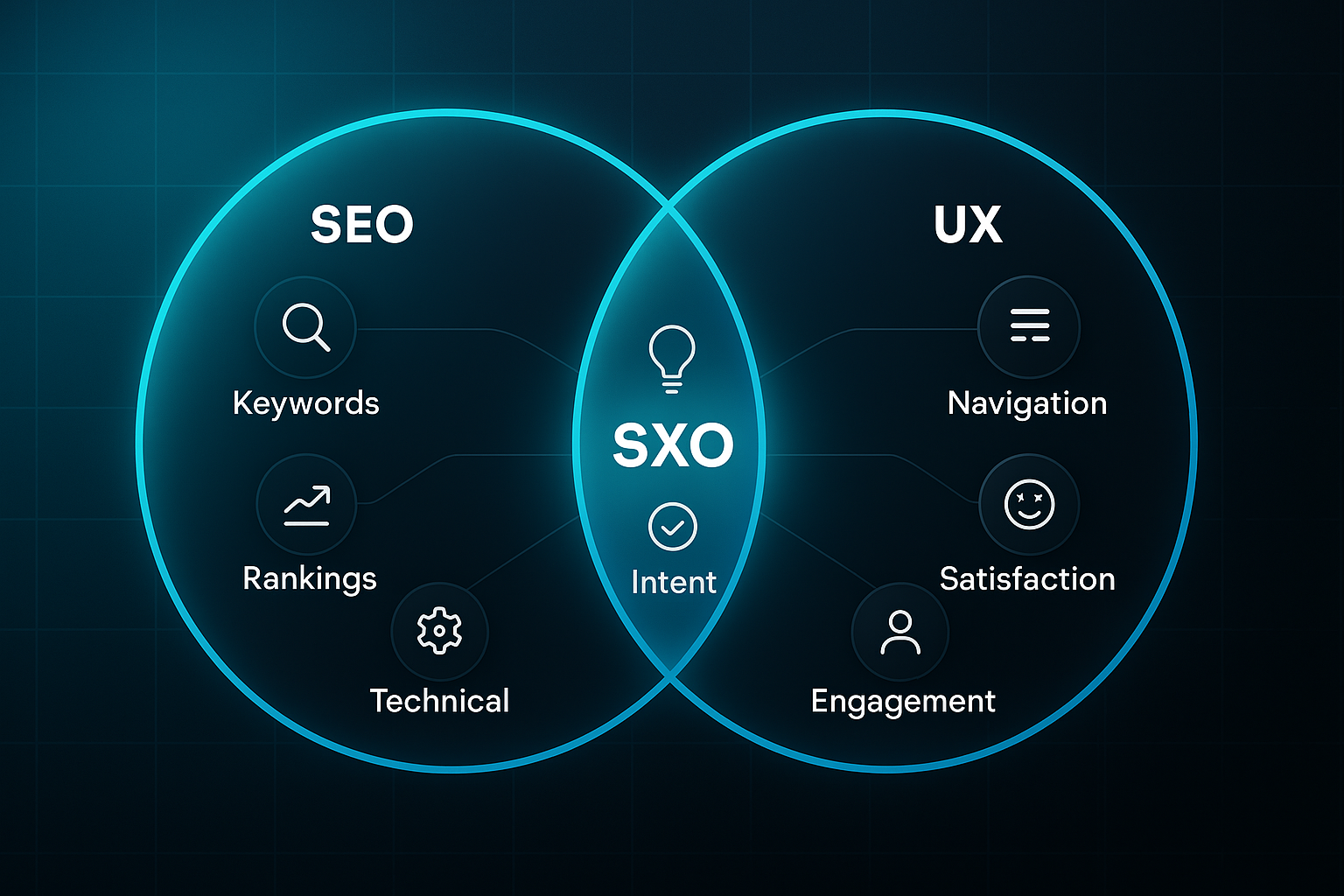
It’s a shift from just getting traffic to creating genuine results.
Focusing on a CRO strategy allows you to maximize the value of the visitors you already have, shifting the goal from simply attracting traffic to generating tangible business outcomes.
How SXO Differs from Traditional SEO
So, what sets SXO apart from traditional SEO? The older approach mainly targets higher rankings and organic clicks, relying on keywords, links and technical improvements.
SXO adds another dimension: the user experience itself. Are visitors finding what they need easily? Is your site fast, intuitive, and helpful? These factors now play a key role.
There’s a difference in what gets measured too. While SEO watches visitor numbers, SXO tracks engagement—bounce rates, session duration and conversions. If your traffic is high but actions are low, SXO highlights what needs fixing.
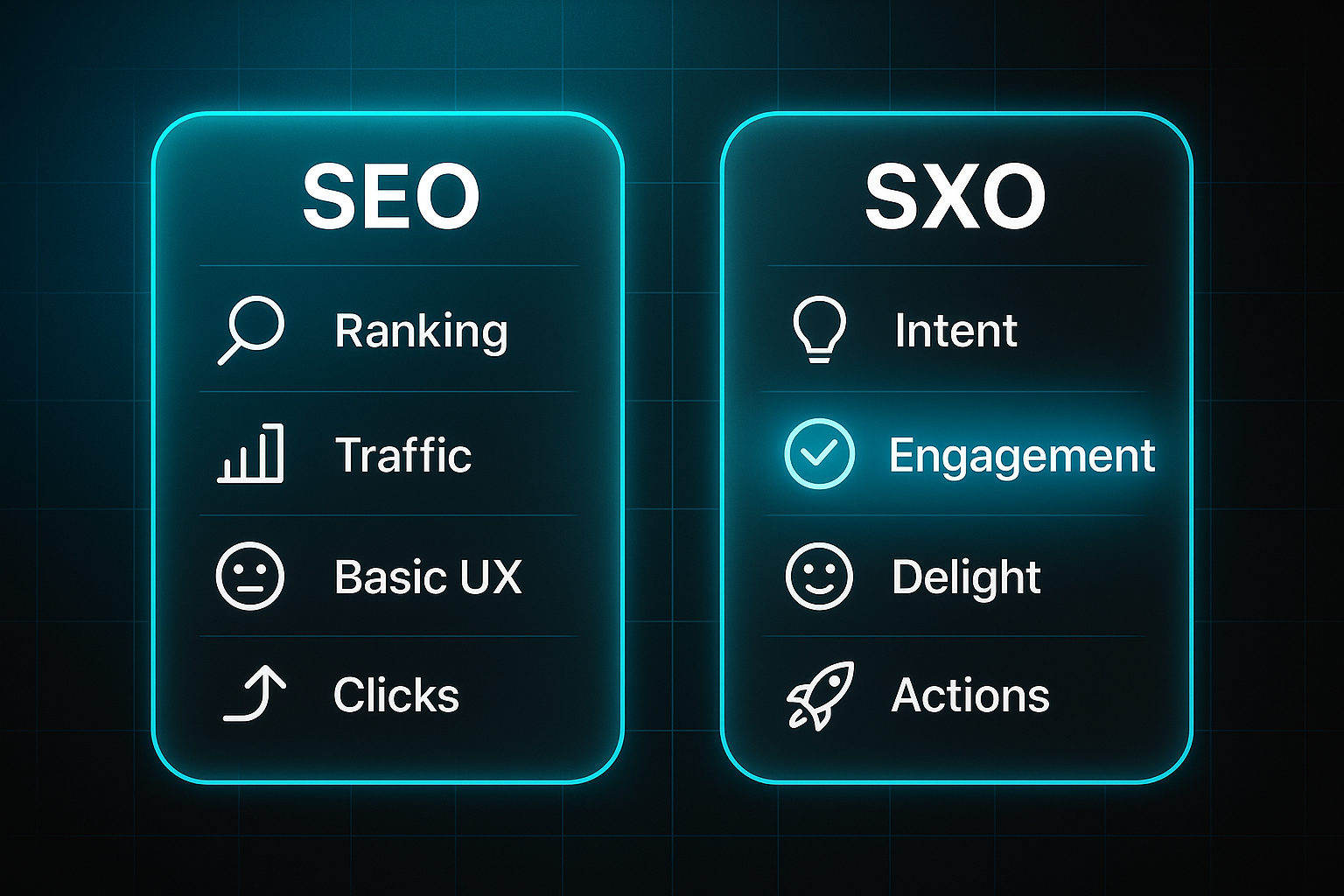
Why SXO Is Gaining Importance
Here’s why SXO is on the rise. User experience signals—like loading speed or mobile friendliness—are now major ranking factors for search engines.
With more people using mobile devices and expecting instant results, just optimising keywords isn’t enough. Advancements like mobile-first indexing and AI-driven search have raised expectations.
Sites investing in SXO often see bounce rates drop and conversions improve. Blending search visibility with satisfaction is now essential for true online success.

The evolution from SEO to SXO
From Keyword Optimisation to Experience Optimisation
Step back in time and SEO meant stuffing pages with keywords and stacking up backlinks. Sure, this pleased search engines, but left real people wanting more.
That all shifted when the big algorithm updates hit. Panda came first, penalising thin or duplicate content. Next, Penguin cracked down on shady backlink tactics. Then Hummingbird upped the ante by helping search engines grasp what users meant, not just what they typed. Machine learning took centre stage with RankBrain and BERT, putting the focus on context and meaning—suddenly, relevance outshone repetition.
Updates like Panda and Penguin initiated the move away from manipulative tactics by targeting low-quality content, content farms, and keyword stuffing, setting the stage for a greater focus on content quality and relevance.
Here’s where it gets interesting. A job site focused on thin content lost ground after a quality update. But when they shifted to in-depth guides and refined usability, visibility bounced back and conversions jumped 35% in just six months.
Why Pure SEO Was No Longer Enough
Focusing only on traffic had obvious shortcomings. Sites might attract visitors, but then see high bounce rates or short session times—clear signs something was missing.
Search engines adapted, elevating mobile-friendliness, quick load speed, and intuitive navigation to core ranking signals. The era of relying solely on technical tweaks faded fast. Now, you need to deliver a smooth, satisfying experience as well.
That’s the real pivot: to thrive online, combining technical brilliance with genuine user satisfaction became non-negotiable—laying the foundation for SXO.

The core pillars of SXO: Bridging SEO and UX
Technical Health
Technical health is the backbone of SXO. If your site loads slowly, visitors leave. Google shows load times rising from 1 to 3 seconds boost bounce risk by 32%. For ecommerce, each extra second in those first five drops conversions 4.42%. With 58.7% of all web visits from mobiles and Google prioritising mobile-first indexing, responsive design is a must. Secure HTTPS, tidy structure, and minimal errors mean stronger rankings and trust.
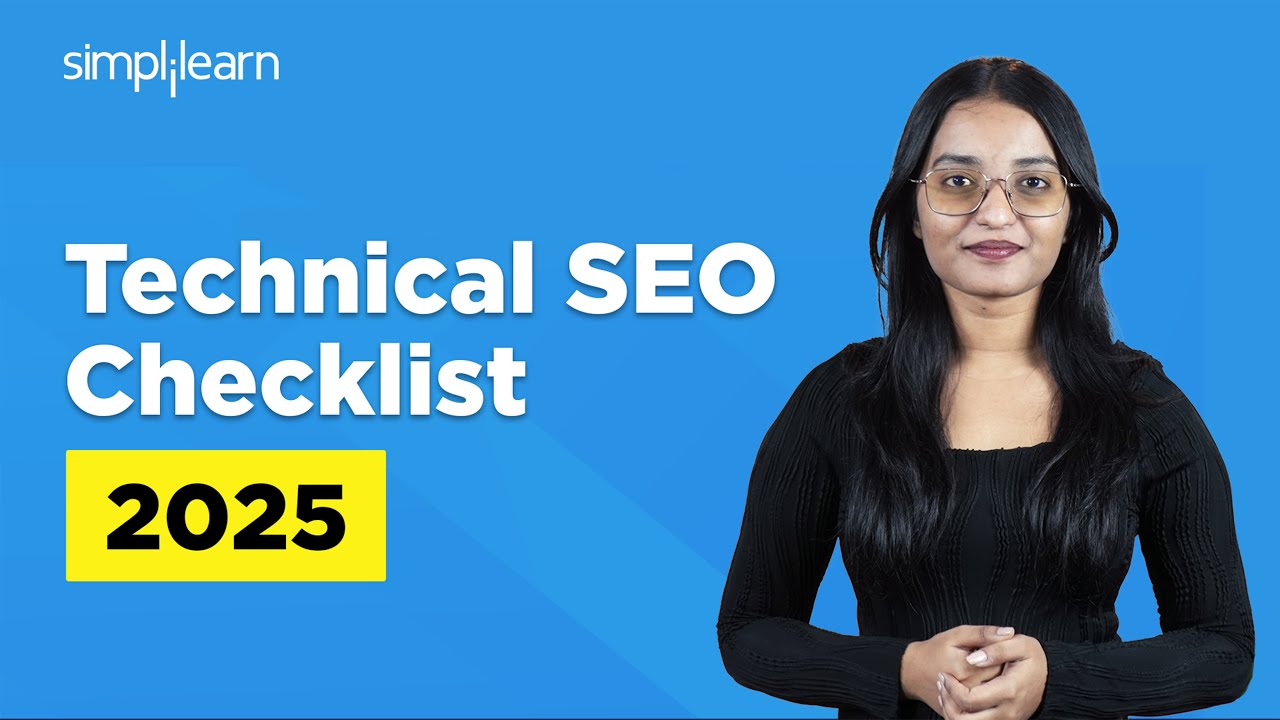
Technical SEO Checklist 2025 | Technical SEO Tutorial 2025 | What Is Technical SEO | Simplilearn
Content Quality & Intent Match
SXO moves beyond keywords; it’s about knowing what users seek. Top brands map intent, offer fast answers, and use visuals. Chunked, targeted sections raise session duration by over 20%. Featured snippets can increase snippet visibility 22–40%. When content truly meets user needs, search relevance and engagement climb.
Search engines use user engagement metrics like bounce rate and average session duration to determine content quality. High-quality content improves these metrics, sending positive signals to search engines about the relevance of your site.
User Experience Fundamentals
Navigation makes a real impact. Clear menus and layouts help both visitors and search engines. With Google’s Core Web Vitals, speed and accessibility are vital. Vodafone optimised Largest Contentful Paint and saw sales leap 8%. Better navigation lifts engagement and, directly, organic growth.

AWS re:Invent 2024 - Vodafone: A global digital customer experience reinvention (CEN102)
E-E-A-T (Experience, Expertise, Authoritativeness, Trust)
Trust relies on showing expertise—think author bios, credentials, and authentic reviews. Secure, honest content is essential, especially for YMYL topics. Tumble’s author bios and testimonials drove higher trust and conversions.
Continuous Improvement & Iteration
SXO isn’t static. Analytics and A/B tests guide improvements. ThatWare’s continuous tweaking in 2024 boosted ecommerce conversions by 32% and dropped bounce rates 27%. Constant small changes keep results strong as searching habits evolve.

Modern ranking factors influenced by SXO
Core Web Vitals and User Signals
Let’s dig into what shapes rankings now. Core Web Vitals—Largest Contentful Paint (LCP), Cumulative Layout Shift (CLS), and the new Interaction to Next Paint (INP)—sit at the heart of Google’s recent updates. With the March 2024 update, INP became essential for measuring real user responsiveness.
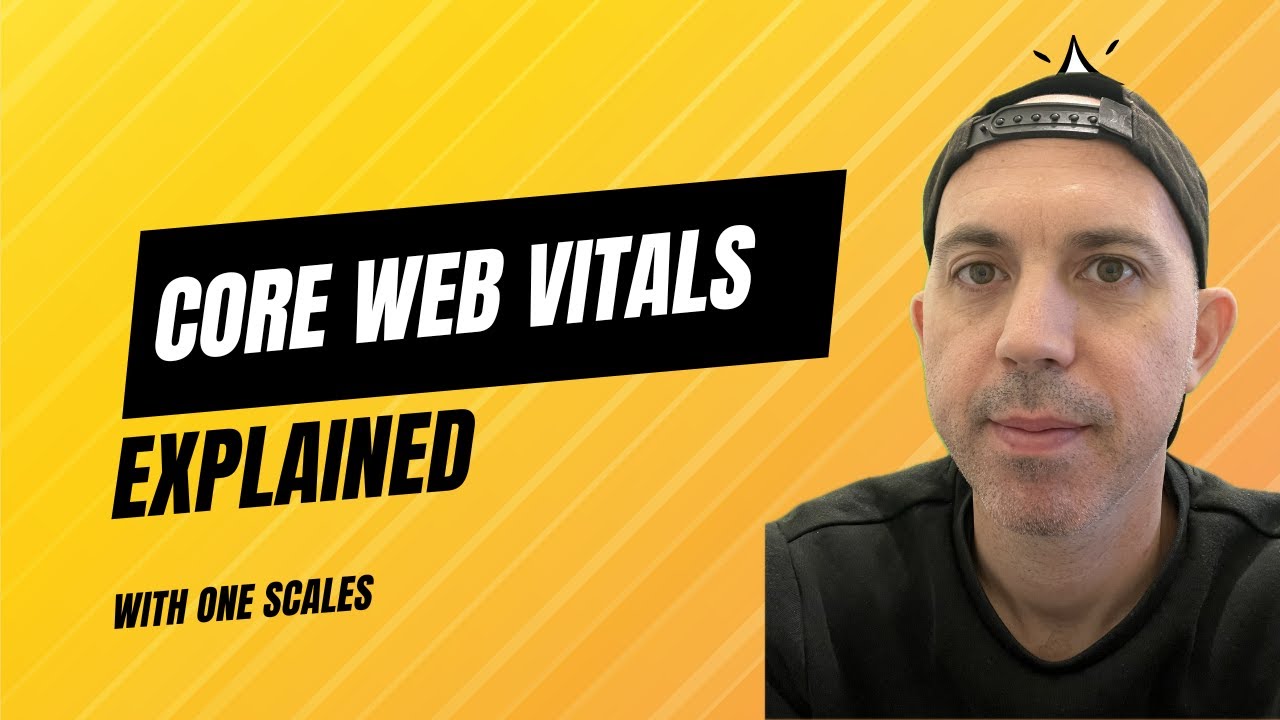
Core Web Vitals Simply Explained (non technical)
A 0.5-second LCP improvement? That alone can boost conversion rates up to 10%. But it’s not just technical metrics. Google watches user behaviour: long dwell time signals satisfaction, but high bounce rates or “pogo-sticking” mean your content might miss the mark—and your rankings could slip.
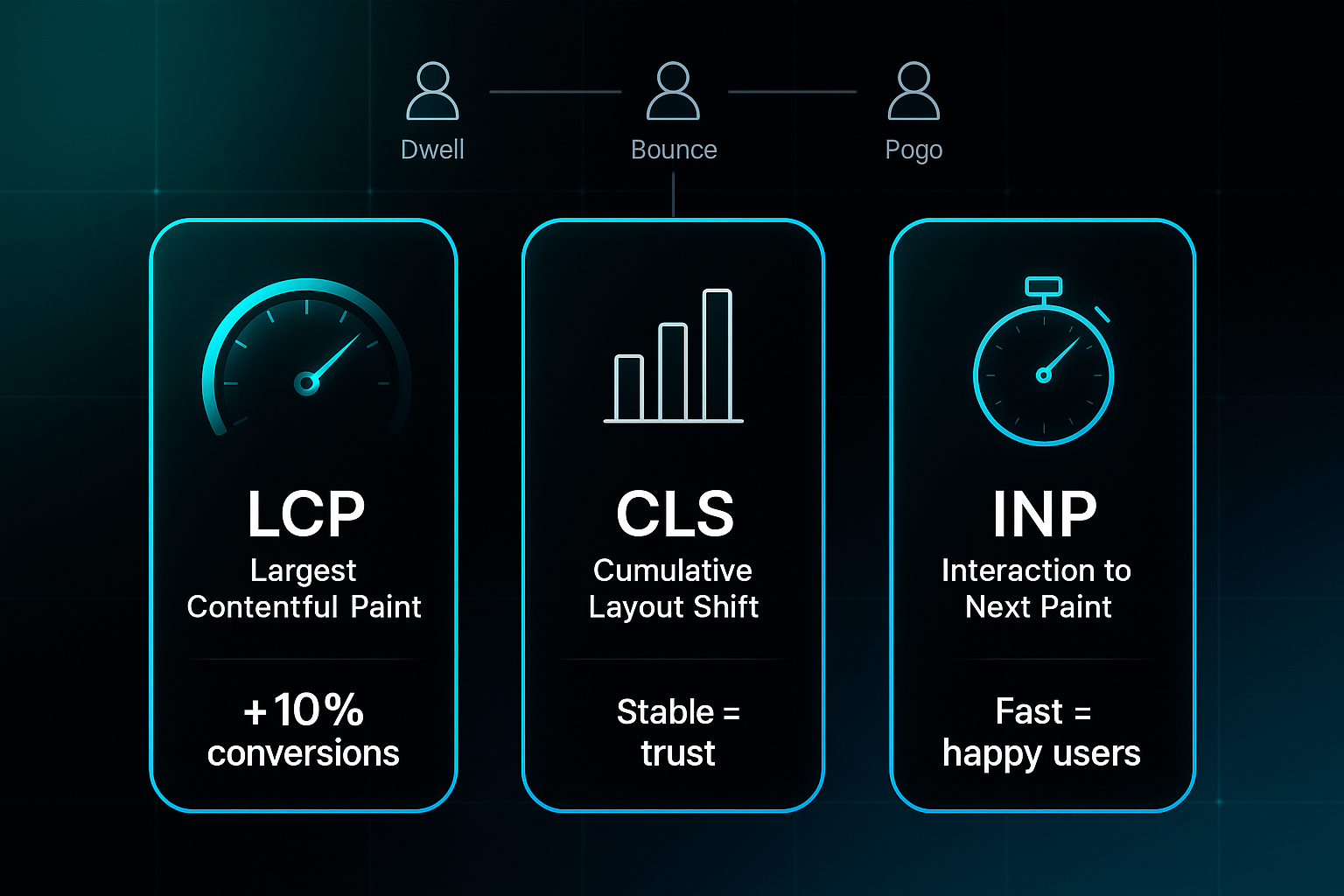
Mobile Friendliness and Security
Today, over 63% of Google searches are on mobile. So, mobile-first indexing is non-negotiable. Sites need easy navigation and legible text for every screen.
HTTPS matters too, acting as a trust badge and ranking factor. Booking.com saw sign-ups climb 13% after revamping mobile UX and moving to HTTPS, while Walmart’s mobile conversions jumped 2% for every second cut from load times.
Content Relevance and Engagement
Google’s Helpful Content update (August 2024) puts the spotlight on original, up-to-date, intent-matching content. Transparent authorship and expert reviews especially help with high-stakes topics.
Authentic, user-focused content now isn’t just recommended—it’s the true engine for SXO success.
Actionable strategies for implementing SXO
Understanding and Mapping User Intent
Let’s talk about what really drives someone to your site: user intent. Every visit is sparked by a goal—normally falling under informational (seeking knowledge), navigational (looking for a resource), or transactional (ready to take action).
Pinpointing why people land on your page is crucial. Do this well, and you boost both user satisfaction and real business results.
But here’s the twist: there’s no single silver bullet for uncovering intent. That’s why top-performing SXO means using several approaches together.
You’ll want to combine insight from different techniques that each reveal a piece of the puzzle:
- Keyword Research & Query Modifiers
Spot intent in search terms and phrases, like 'how to' (informational), 'review', or 'buy' (action). - On-site Analytics
Heatmaps, user flows, and exit data show if navigation supports users’ goals or causes friction. - User Surveys & Interviews
Short polls let you hear directly from your audience—what they wanted, and what got in the way. - Session Recordings
Watch user journeys to see where visitors get confused or where content doesn’t match expectations.
Once you have a handle on all this data, map intent stages to your site’s user journeys. Early visitors often crave inspiration or advice, while ready-to-buy users want frictionless navigation and a clear path to action.

That’s where microfunnels come in—think content pathways guiding people from first thought to final click. Align menus, filters, and category pages around specific intent groups, so visitors always land where they want.
A real-world example? Flos USA’s 2024 relaunch shows this in action. They segmented users: galleries for creative types (informational), calculators for professionals (transactional). New video walkthroughs upped flagship page dwell time by 22%.
And by trimming their checkout from seven steps down to three, cart abandonment dropped 29%. Overall, conversion rates jumped by 37% and repeat visits by 18%—all thanks to continuous, intent-driven improvements.
This is what an actionable SXO strategy looks like when it’s woven into each corner of your digital experience.
A real-world SXO case study: End-to-end example
Initial Audit and Data Gathering
Let’s see SXO in action. The SmartBuyGlasses Optical Center blog kicked things off with a thorough audit—checking technical SEO, content, user behaviour, and engagement.
What surfaced? Fragmented content, 32 broken links, 7.2-second mobile load times, and a confusing menu. When mapping user journeys, they saw visitors abandon the site when switching from advice to shop pages. Result: high bounce rates and missed conversions.
SEO and Technical Improvements
Instead of patching over issues, they rebuilt around intent-led categories and reworked internal links to guide users smoothly from advice to products. All 404s were fixed, mobile speed dropped below 2.5 seconds, and schema markup made FAQs and reviews stand out in search.
The impact? A 45% boost in organic traffic and a 31% increase in session duration.
UX Redesign and Content Enrichment
Navigation got a full rethink. The popular 'Blue Light Glasses' section was united with enhanced FAQs and fresh visuals.
Accessibility came first, hitting WCAG 2.1 and ARIA standards—crucial with 68% of visits from mobiles.
Conversion Optimisation and Testing
Through A/B tests, the checkout process shrank from six steps to three. They targeted drop-off points precisely.
End results? A 24% jump in completed checkouts and 17% fewer abandoned baskets.
Ongoing Maintenance and Monitoring
They didn’t stop there. Key metrics were tracked daily, and weekly micro-improvements rolled out based on session recordings and heatmaps.
Summary of Results and Key Takeaways
Six months later, organic sessions rose 62%, engagement climbed 36%, and checkouts went up 28%.
Scaling medical content took teamwork with optometrists and regulatory checks. The real lesson? Continuous alignment of content, UX, and SEO drives lasting business growth—even in tricky, regulated sectors.
Common misconceptions and pitfalls in SXO
SXO vs. Fast Site Speed
Is speed everything? Not quite. Fast load times matter, but they’re just the starting line. An apparel retailer made their site snappier, but conversions barely changed. Things only improved when they fixed messy menus, made calls to action stand out, and added trust badges. Speed alone doesn’t deliver results; you need to blend performance with intuitive navigation and trust signals.
The Silo Trap: SEO vs. UX
Ever seen teams stuck in silos? A SaaS business kept SEO and UX separate, so users struggled to find support. Once these teams joined forces, session duration soared and support requests dropped by 24%. When SEO, UX, and conversion specialists actually work together, journeys flow and growth follows.
Belief in Full Automation
Can automation fix everything? Sadly, no. A skincare brand leaned on automated audits, but people still got lost amid confusing categories and inaccessible features. Hands-on reviews and user testing are vital for genuine SXO—automation is groundwork, not the full plan.
Mistaking Rankings for Success
And those top rankings? Don’t be fooled. One electronics shop ranked high in searches, but conversions lagged. By improving mobile navigation and clarifying support, bounce rates fell 19% and sales climbed 14%. Visibility only counts when users act—that’s the heart of SXO.
Measuring SXO success: Metrics and tools
SEO and UX Performance Indicators
So, how can you tell if SXO is delivering results? It’s not just about pulling in more visitors—it’s about what they do next.
You’ll want to watch keyword rankings and organic traffic to track discoverability. But for real SXO insight, dig into metrics like session duration, dwell time, bounce rate, pages per session, and conversion rates—all of which show genuine engagement.
Repeat visit rates matter, too. If people return, you’re clearly meeting their needs. And let’s not forget Core Web Vitals: Largest Contentful Paint (LCP), Cumulative Layout Shift (CLS), and Interaction to Next Paint (INP)—these heavily influence search results and reflect real-world site experience.
When you see stronger conversions, longer visits, and improved Core Web Vitals, you’re on the right track.
Key SXO Tools and Solutions
It takes both numbers and real user feedback to see the full picture.
Google Analytics 4 reveals session patterns and conversions. Google Search Console tracks impressions, rising keywords, and Web Vitals.

Google Analytics 4 Tutorial for Beginners (2024) || 1-hour GA4 course
Want deeper insights? Hotjar and Crazy Egg uncover on-page behaviour. And if you prefer an all-in-one approach, SEOSwarm brings technical SEO, UX insights, and conversion tracking together for continuous improvement.
Regular check-ins with these tools help you stay ahead as SXO keeps evolving.
Why SXO matters: Trends and business benefits
Industry and Google Trends
What’s putting SXO centre stage right now? Google’s 2024 and 2025 updates have made Core Web Vitals—especially Largest Contentful Paint (LCP) and Interaction to Next Paint (INP)—critical for search rankings.
It’s no longer about ticking off keywords. Today, smooth user experience, mobile optimisation, and original intent-matched content are essential. Google increasingly rewards genuinely useful information, so sites combining SEO with UX are outpacing old, keyword-heavy tactics.
Tangible Business Outcomes
And what does this shift mean for results? SXO drives real improvements—not just traffic numbers.
For example, Allbirds saw mobile conversions jump 22% and bounce rates fall 15% after improving their Core Web Vitals. Booking.com sharpened INP and content, driving session duration up 18% and direct bookings higher by 12%.
The takeaway: brands that prioritise SXO ride out search changes and maintain growth, while pure SEO sites risk fading away.
Operationalizing SXO in your workflows
Bringing SXO to life starts with solid workflows that link technical SEO, UX, content, and analytics. Cut out team silos, and decisions become faster, with improvements far easier to achieve.
Cross-Team Collaboration
So, how do you get everyone working together? Combining SEO, UX, and content teams is crucial. Siemens, for example, used one shared platform for project docs—making access easier and reducing mistakes. Kanban boards and RACI matrices clarify who’s responsible for what. Regular team meetings with live analytics reviews mean you can pivot quickly and see better results.
Workflow Structures for SXO
Smooth SXO relies on monthly audits plus quarterly deep dives. Automation tools like Monday.com and Smartsheet set reminders and route assets—saving time and lowering risk. Analytics dashboards in each sprint guide data-led tweaks. Firms like Whitney Consulting scale SXO by centralising briefs, mapping roles, automating checks, and running continuous testing—making the process both sustainable and effective.
Scaling SXO: The role of automation, analytics, and expertise
Automated SXO Content Strategy Platforms
AI-powered SXO platforms like SEOSwarm automate research, content creation, formatting, and optimisation. What’s the impact? Teams reliably produce more, and engagement rates jump 25–40%. Routine errors are slashed by over 60% thanks to automated checks.
Integration for Speed and Accessibility
A standout here is blog-in-one-minute, an add-on for SEOSwarm. It enables fully optimised blog hubs almost instantly—technical SEO and cloud hosting included. Campaigns launch in hours, not days, with simple set-up. It’s flexible for any site.
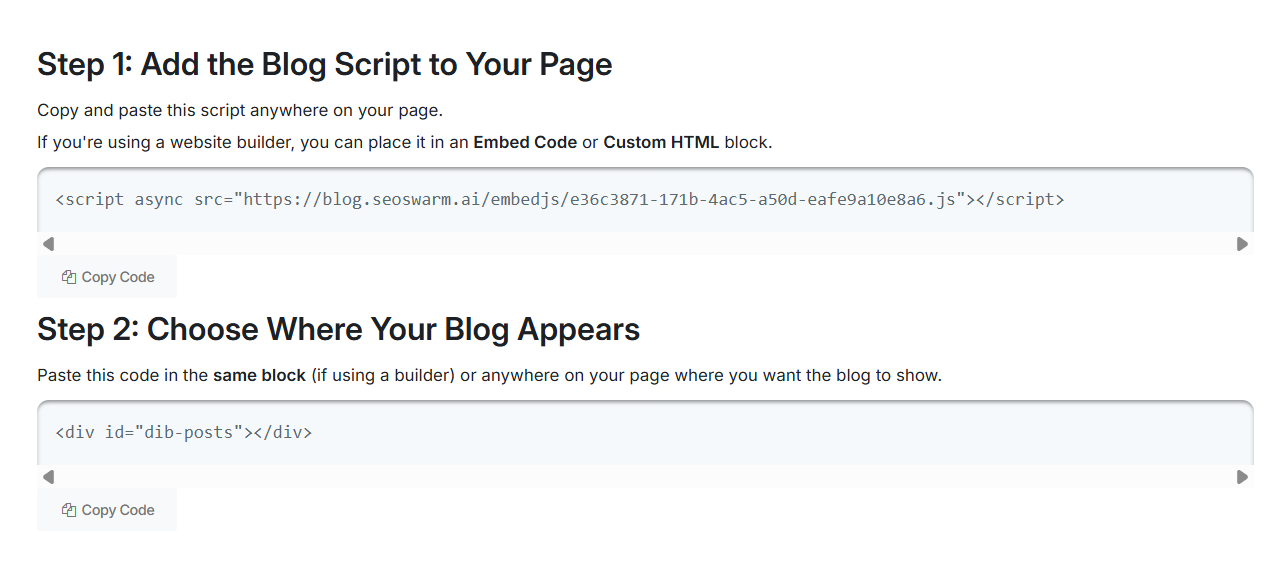
Balancing Automation and Human Expertise
Automation excels at speeding up repetitive jobs. Still, human editors are essential—they check facts, ensure nuance, and keep your brand’s voice. The secret? AI drafts, people refine—delivering scale and quality.
Overcoming Resource Constraints
Analytics and automation let even small teams scale SXO. Automating technical details and metadata cuts errors by 60%, saves effort, and puts new content live within 24 hours.
SXO Scaling Outcomes: At-a-Glance
Here’s how these approaches deliver:
- SEOSwarm
2–5x more articles, 25–40% higher engagement, same-day launches - blog-in-one-minute
Instant blog hubs, optimised layouts, launches in hours - Hybrid (AI + Human)
High consistency, best brand fit, rapid and strategic output
Blending automation with expert oversight reliably boosts visibility, engagement, and business results—the real key to scaling SXO.

AI-Powered
SEO Content Strategy
See the AI platform that's replacing entire content teams
(with better results).

The future of SXO: What’s next?
Increasing Demands from Search and Users
User expectations are rapidly changing. With the growth of AI-powered search, zero-click results, and voice or visual queries, people now want immediate, personalised experiences on any device.
By 2024, about 40% of searches end without a click—thanks to featured snippets and AI Overviews that answer questions right on the results page. To stay visible, brands need to use schema markup, conversational content, and audit their snippet presence. It’s no longer just about ranking; now it’s about engagement, dwell time, and accessibility, as search engines increasingly reward smooth, satisfying journeys.
The Rise of DXO and Beyond
SXO is just the beginning. Digital Experience Optimisation (DXO) covers every digital touchpoint—search, social, apps, and customer support. DXO relies on personalisation, modular content, AI-driven Q&A, and voice optimisation. New KPIs like AI summary mentions and multi-channel engagement help track performance.
Continuous Adaptation
In a world of fast-moving algorithms and habits, constant testing is vital. Firms such as HubSpot use real-time analytics, A/B experiments, and ongoing cross-team reviews—delivering conversion lifts of 10% or more.
SXO Q&A: Your most common questions answered
SXO vs. Speed and Plugins
Let’s clear this up—SXO is much more than speeding up your site or installing plugins. While technical and speed optimisations matter, real SXO means refining content, streamlining navigation, and fulfilling user intent at every step. It’s a continuous team effort, not a set-and-forget job.
Team and Workflow Structure
Great SXO comes from collaboration between SEO and UX pros. When content, technical checks, and analytics all connect—but with teams playing to their strengths—sites catch problems early and boost both visibility and user satisfaction.
Automation Limits in SXO
Automation helps with audits or rapid publishing but can’t replace human insight for creative content and strategy. The magic happens when both work in tandem—smart tools plus expert judgement.
Solution Provider Solution Structure
Here’s a useful detail: blog-in-one-minute is a separate subscription from SEOSwarm. SEOSwarm manages complete SXO strategy, while blog-in-one-minute powers fast, scalable, optimised blog rollouts.
Blog-in-one-minute
Add a fully SEO-optimised blog to your website with just 2 lines of code.
Learn more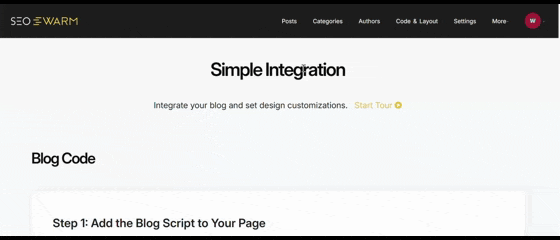
Making SXO Work for Real Engagement
Traffic alone is no longer the finish line—what matters is what visitors actually do once they arrive. SXO bridges the gap between visibility and real engagement, blending technical SEO, content quality, and seamless user experience into one continuous process.
If you want results, start by mapping user intent, auditing your site’s technical health, and breaking down team silos. Use analytics and A/B testing to guide improvements, and don’t rely on automation alone—human insight is essential for lasting impact. I recommend setting monthly reviews and collaborating across SEO, UX, and content teams to keep your site evolving.
The sites that thrive aren’t just easy to find—they’re easy to use, trustworthy, and always improving. SXO isn’t a checklist; it’s an ongoing commitment to turning every visit into meaningful action.
- Wil







